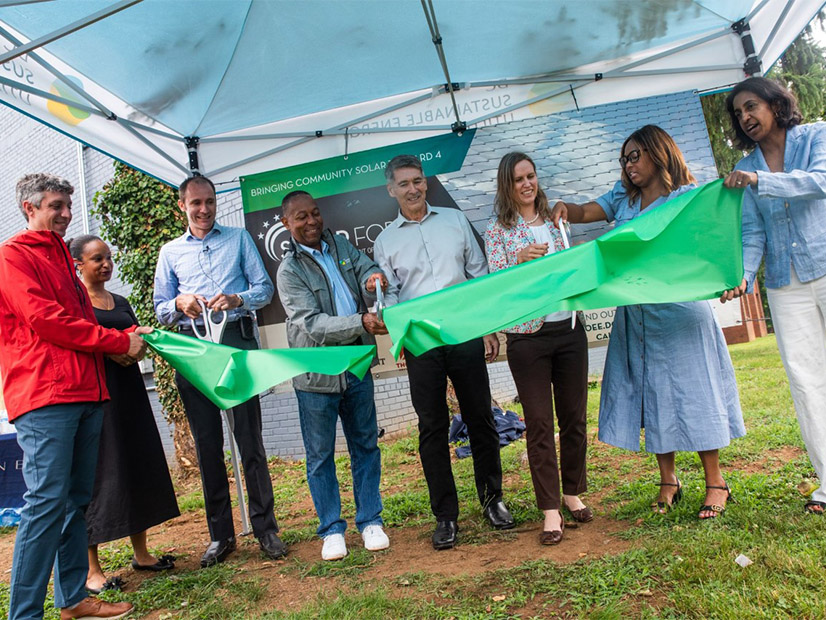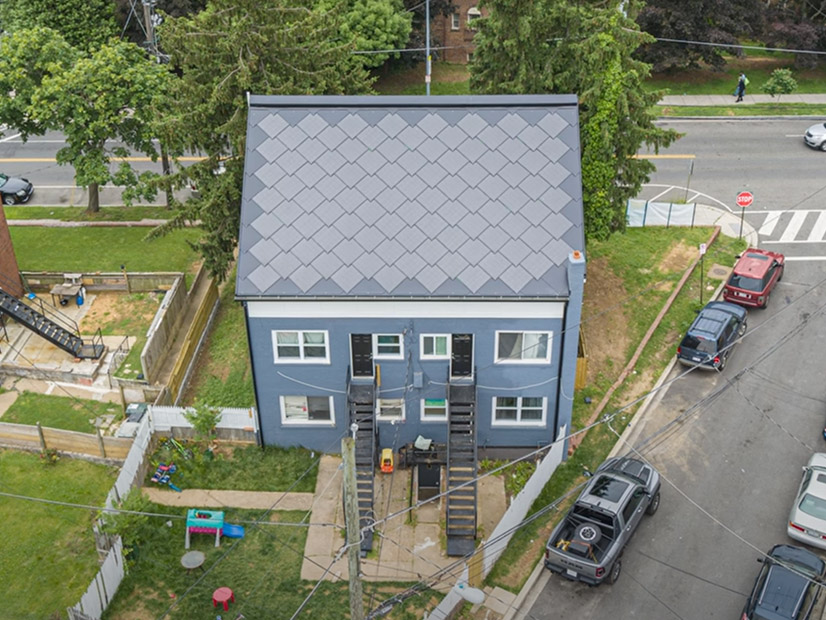
WASHINGTON — The “dragonscale” solar shingles that are powering Google’s (NASDAQ:GOOGL) massive eco-friendly campus in California’s Silicon Valley will soon also be pumping out electrons from the much smaller rooftop of a multifamily building in D.C., while cutting electric bills in half for about a half-dozen low-income families in the city.
The 21-kW installation in a residential neighborhood is the newest community solar project in D.C.’s Solar for All program, which to date has halved electric bills for about 6,600 households across the city. It is also the city’s first solar shingle project, hailed by local officials and the project developers who turned out on a rainy Monday afternoon to cut a symbolic green ribbon in front of the building.
Known in the industry as building-integrated PV (BIPV), the diamond-shaped solar shingles each produce 110 W of power. They were developed in Europe by SunStyle, a Chicago-based company with a fast-expanding international footprint, according to the company’s website. While the dragonscale shingles have been used in hundreds of projects in Europe, the Google campus and the D.C. multifamily rooftop are their first appearance in the U.S., said CEO Gene Rosendale.
The shingles are “similar to any solar panel, just smaller” and sturdier, Rosendale said. They can be installed like a standard slate roof, and essentially become the roof, he said.

“Installers have to walk on it,” Rosendale said, including work crews loaded up with heavy equipment. “They can walk on it while they are installing it.”
The shingles also meet all required industry standards for BIPV, which include safety requirements for both solar and roofing materials, such as resistance to hail and snowstorms, he said.
“This project represents not just another solar installation; it’s emblematic of where we see the future of the sustainable built environment going,” said Jessica Pitts, co-founder and principal at Flywheel Development, the D.C.-based developer that built the project. “It is the beginning of a transformation away from sustainable infrastructure being extra, being in addition to the materials of yesterday, and a move toward a future where sustainability is truly integrated into our surroundings, into our homes, into our buildings and becomes part of the fabric of our communities.”
For City Councilmember Janeese Lewis George, the project reflects the moral commitment local officials in the nation’s capital have made in the face of the “devastating climate crisis that threatens every facet of our lives.”
“We have a moral responsibility to revolutionize our energy,” Lewis George said. “We have a moral responsibility to break barriers by making green energy inclusive and accessible for everyone through programs like Solar for All, and we have a moral responsibility to collaborate across agencies, communities and the private sector to make it all happen.”
‘The Innovative Stuff’
D.C.’s Solar for All program began funding projects in 2019, with the ambitious goal of installing enough solar — both residential and commercial projects — within the district’s 68.3 square miles to cut electricity bills in half for 100,000 low-income households.
With a target of 100% clean power by 2032, D.C.’s renewable portfolio standard requires utilities and retail electricity suppliers serving the city to provide increasing amounts of power from renewable energy every year or pay “alternative compliance fees.” That money has been a major revenue stream for Solar for All, allowing the city to pay significant incentives to developers building new projects for the program.
Incentives this year are $1.25/W for commercial projects and $1.50/W for single-family rooftop projects, according to the DC Sustainable Energy Utility, which administers Solar for All. Over the past three years, such incentives have helped to put solar panels on 328 single-family homes and to install 166 community solar projects.
The solar shingle project is one of 40 community projects Solar for All expects to complete by the end of the year, said Ted Trabue, the utility’s managing director.
Project financing is also helped by D.C.’s active market for solar renewable energy credits, which are currently selling around $300 per credit, down from $400 earlier this year.
And for projects like the solar shingle roof, DC Green Bank, founded in 2018, helps fill funding gaps, said Brandi Colander, the bank’s board chair.
“We take on the hard stuff; we take on the innovative stuff … that others were not quite sure they wanted to make a bet on,” Colander said at the ribbon cutting. “We are investing in helping people figure out how to navigate the system so they can make more pioneering investments like the one we have standing before us today.”
In the past three years, the bank has provided funding for a series of Flywheel projects, said Eli Hopson, the bank’s CEO.
“It’s harder for smaller organizations like Flywheel to find [funding],” Hopson said. “They had done smaller projects, but they hadn’t done anything at [a larger] scale.”
The company now has a track record of completing larger projects — including 24 community solar projects for Solar for All — so providing a construction loan for the solar shingle project was more straightforward, he said.
For Flywheel, the money was crucial. Before installation began, the four-unit building had a flat roof, and Pitts said the company wanted to build a traditional pitched roof to maximize power output from the solar shingles, which she estimated will generate about 27,000 kWh/year. The project is in the final stages of the interconnection process and could be online in the coming weeks, she said.
BIPV’s Early-stage Economics
Now that Flywheel has completed its first solar shingle project, Pitts is hoping more will follow. “I like the product and see a lot of potential in the combined solar roof technology,” she said. “We already have interest from additional property owners.”
Still, BIPV has yet to break out of its niche status in the U.S. solar market, with its slow growth attributed to the expense and inefficiency of solar roofing compared to panels. According to a recent report from industry analysts Grand View Research, the BIPV market in the U.S. was valued around $2.3 billion in 2021, but it could see a compound annual growth rate of 20.7% between now and 2030.
Tesla and GAF Energy are the major players, but the market is experiencing supply chain challenges, with Tesla putting a hold on its solar roofing installations in March. Despite such market turbulence, Rosendale said the raised awareness of solar roofing created by these companies has made it a perfect time for SunStyle to enter the U.S. market.
At more than $35 per square foot, SunStyle’s dragonscale shingles are still a premium-priced roofing choice, he said, but “it’s early-stage economics” for BIPV. “Over time, as the volume gets larger, it will become more mainstream,” he said.



